
KURDISTAN
GROUND OF THE CIVILIZATION
KURDISTAN
- "The Fertile/Golden Crescent"...
a country where civilisation once was born, but now destroyed beyond recognition,
mainly by Islamo-Fascist Invader Turks.
Home †|††DestpÍk††|††Ana Sayfa

THE AMERICAN AUTHOR & JOURNALIST Harry G. Nickles
THE FOOD THAT LAUNCHED CIVILIZATION
© 1969 Time inc. All right reserved
North of the modern city of Baghdad begins Kurdistan, a hilly, grassy region in Iraq, Iran and Turkey with a pleasant, cool climate. It has few important modern cities or spectacular ruins (1); its peasants lead lives that for centuries have changed hardly at all. But historically Kurdistan is in a class by itself. What makes the region unique is an ancient event in the history of food and of mankind – the domestication of plants and animals. According to all available archeological evidence, this great achievment first took place here. It gave man his first dependable and manageable food supply, and it provided the foundation upon which was built all civilization: villages, cities, nations, empires, writing, literature, law, science.
No one knows what those first farmers of Kurdistan looked like, what colour their faces were or what sort of language they spoke. They were forgotten thousands of years before the beginning of recorded history and are known today only through scanty remains found under the mounds of debris, called tells, that dots the Middle East. But the old bones, tool fragments and seeds reveal that these men and women turned mankind from total dependence on the accidental gifts of nature to control over sources of food.
For hundreds of thousands of years after men appeared on earth the way they got their food changed hardly at all. They lived in small bands, eating what nature offered. The women and children gathered fruits, nuts and seeds, dug up roots and collected slow-moving game such as tortoises and snails. The men hunted almost any animal they could kill. Sometimes they ate well, but hunger was an ever-present danger. When the band had eaten all their natural food in one locality, it moved on.
Very gradually, over tens of thousands of years, man’s foraging techniques improved. He devised better tools and weapons, hunted more skilfully, learned to use fire and made better use of wild vegetable foods. About 9000 B.C. some of the bands learned to live fairly well without continual wandering. This could be done only in favoured parts of the earth, and one of these natural Gardens of Eden was in what is now northern Iraq, where wild sheep ranged the plains and several kinds of coarse grass - the ancestors of modern wheat and barley – produced heads of edible seeds.
It is no accident, then, that sheep and wheat – two basic foods of the modern Middle East – were tamed first. In both cases the process was slow, for primitive people are stubbornly coservative. Most experts believe that sheeps were man’s first controlled source of food and that their domestication was an outgrowth of systematic hunting. At intervals, men and boys would string out in lines, shouting and waving their arms to drive wild sheep into narrow places in the hills where they could be called easily. The next step was to pen captured animals in a steep ravine with a fence across its mouth.
For centuries, perhaps for a thousand years or two, such sheep-keeping was a hit-or-miss thing, and most of the captive sheep were eaten when winter came on. Eventually, presumably during especially mild winters, a few sheep were kept alive until spring, grazing when there was grass, fed with stored hay when there was not. In this way they began to reproduce their own kind in captivity and gradually evolved into domestic sheep. The strongest and least tractable animals may have been killed first, so the breed became tamer and tamer. At last the once-wild sheep were tame enough to graze peacefully in flocks, making no attempt to escape.
The acquisition of domesticated sheep made a dramatic change in man’s food supply and his way of life. The flocks produced more meat than wild sheep had done, and the supply was more dependable. People no longer went meatless when a few hunts failed.
Even more important was the cultivation of plants, for it provided a previously unknown abundance of food, and most significant of all, it permitted men to live in permanent settlements. This feat may have been first accomplished by women, and its first triumph was wheat, which still grows wild in Kurdistan and is harvested in the ancient food-gathering way. Tiriticum Dicoccoides, the ancestor of nearly all cultivated wheat (2), thrives best on moist uplands between 2000 and 4300 feet in altitude. A field of Tiriticum Dicoccoides looks rather like a thin stand of domesticated wheat, but there are important differences. The heads of the wild wheat are shorter and the grains smaller, and each grain is tightly enclosed in its scratchy husk. When a head ripens, its grains tend to break away from the central stem, to be dispersed by wind or animals.
At first the women gathered wild wheat merely by breaking off the heads or pulling the grains from them. Later they used wooden or bone sickles set with small flints, which would cut several stalks at a time. Ancient sickles have been found in the region, with flints that are polished just back of the edge-polished millennia ago by silica particles in the wheat straw.
Gathering wild wheat, even with a cleverly made sickle, is not agriculture. Gradually, however, the women came to realize that their wheat supply could be increased by planting some of the grain they had gathered in places where wild wheat did not grow naturally. They may have gotten this radical idea by observing that wet kernels often sprouted, forming small, green plants like the ones they saw growing wild.
It is anyone’s guess what those earliest cultivated fields were like. Perhaps the women first sowed the seed in places where floods had covered the ground with bare silt, or they may have looked for patches of thin sod and spaded them after a fashion with their root-digging sticks. Either way would also grow well if planted lower down, on more fertile plains and foothills.
Man’s first controlled food supplies, sheep and wheat, became the basis of a truly agricultural life. As soon as the sheep were docile enough to be driven to pasture in the morning and back to safety at night, they could range over a considerable area, turning and nourishing meat the plentiful grass and weeds that human stomachs could not digest. Wheat was even more valuable , partly because it made food abundant but also because it made food that could be stored for a long time. Two or three acres of good land planted in wheat would, with luck, provide the major part of a family’s food for a year. A village of several hundred people could live on its sheep and wheat and never go more than a mile from its centre.
It was not quite as simple as that, of course. Not all the land was good, and little was known about how to keep it productive. Also, there was defence to think about; a village of well-fed farmers was likely to be raided by hungry nomadic hunters. But villages did flourish on domestical animals and wheat. The most famous of them is Jarmo, first excavated in 1948 by an expedition from the University of Chicago led by Robert J. Braidwood.
The Jarmo tell is a low ground in the foothills of northern Iraq east of the oil town of Kirkuk. Like many other Middle Eastern mounds it is mud mixed with debris from successive villages built on its site. Braidwood found at least 15 distinct levels, each representing a somewhat different stage of development. In the deepest level, 25 feet down, he found the oldest, most primitive culture of all, a village that had barely achieved the agricultural way of life. It was built about 6800 B.C. In a sense, this date can be said to mark the start of man’s slow progress toward civilization.
The original Jarmo had about 30 houses covering three acres. It may have had something like 200 habitants, and they were certainly farmers. Many sheep bones were found in what must once have been unpleasantly racking refuse heaps, and a large proportion of them were of yearlings. This is a likely age for the slaughter of domestic sheep, but an unlikely result of hunting, which brings in animals of all ages.
Jarmo’s wheat had a great disadvantage from the primitive housewife’s point of view; the husk encasing each kernel was rough and tough, laborious to remove from the grain. Modern peasants pound wheat in a mortar and winnow off the husks, and the women of Jarmo probably did the same. What they did next is known with some certainty. They put the cleaned grain on curved, hollowed-out stones and ground it to flour with smaller stones. Such “saddle mills” were used for thousands of years with little change. The earliest bread was baked in thin cakes on the flat, fire-blackened stones found on many ancient hearths. Even today, if you walk into a peasant’s cottage in modern Kurdistan, you will find the woman of the house making delicious bread in this 9 000 year-old way, though she is apt to bake it on metal sheets over a small fire instead of on hot stones; civilization – the keyword at stake.
The first people of Jarmo had no metal, of course, and not even pottery, only baskets and stone bowls. It is not likely that they often set their bowls on the fire, but they may have cooked grain in water in depressions lined with baked clay, heating the by adding hot stones until it boiled. The product was probably an undercooked porridge. Meat may also have been added, but much patience and many hot stones would be needed to tenderize it much by this sort of boiling. Roasting over coals – a cooking method much older than agriculture – would yield a better-tasting dish.
Well above the bottom level of the Jarmo mound pottery appears, and with it came new cooking possibilities. Now boiling could make the toughest meat tender and produce satisfying soups and stews. Wheat could be made into nutlike-flavoured bulghur (3) by boiling the grains, as is still done in the Middle East. Tough roots could be softened, taking a heavy task off human teeth. “Beehive” ovens of clay also appear at the upper levels of the Jarmo mound. At first they may have been used for drying or roasting wheat, but the same ovens could roast meat or bake bread.
Peas, lentils and other crops came to supplement wheat. Goats were domesticated not long after sheep, but cattle and pigs came much later. Jarmo’s cuisine could not have been elegant, but except for the lack of chicken and certain dairy products, it did not differ much from the food of peasant villages in the Middle East today. In fact, the basic dishes of a typical meal in a Syrian restaurant in New York – stewed mutton, bulghur and thin sheets of bread – could have been served in ancient Jarmo.
The simple but reliable wheat-and-mutton diet had a profound effect on the lives of the first farmers. In the earliest agricultural villages, such as the Jarmo mound, houses were much alike; there were no identifiable workshops or luxury quarters. But as farming improved, it yielded more than enough food for the farmers, and they began to barter their surplus for goods produced by non farmers who had special skills. Later villages supported specialized potters who produced much better pottery than the farmers could make in their spare time. Other specialists turned out superior stone, bone or wooden tools, received a share of the village’s surplus and formed a growing class of skilled artisans. Still others, the precursors of the merchant class, made long journeys to exchange the village’s products for things it did not have, such as obsidian to make sharp knives.
Soon after farming began, the farmers were confronted with the troublesome problem of who owned what. People who are hunter-gatherers generally have little concept of property. They own their tools, weapons, clothing and personal objects, but hunting territory is shared by all alike and shelter is too temporary to be considered important. Farmers are different; they live in permanent houses, and they need to know what land to cultivate and to graze their animals. As population increased, law and government were called for to settle conflicts over land and other property rights.
Archaeologists do not know in detail what kind of government the farmers first developed. In the beginning it was probably quite informal; public policy may have been argued out before the whole community or before a council of elders. Elsewhere in the Middle East, villages came to include what appear to be temple premises in their centres. Temples imply an established priesthood, and when priests can convince the people that they have influence with the gods, they quickly gain both property and power. So their first rulers of the villages may well have been priest-chieftains who performed mysterious rites in the temples and acted as judges over the people.
The people of the small villages in the hills of Kurdistan did not travel far or fast on this road to advanced civilization. They soon achieved a way of life that fitted the environment and had little need to change, but eventually their population overflowed the available land in the cool hill country. Some began to move out of the hills, and one of the places they went was Mesopotamia, the low, flat plain of the Tigris and Euphrates rivers that now makes up southern Iraq. The climate there was hot, and the rainfall was too little to grow crops dependably, but about 5500 B.C. the pioneers on the flatlands learned to irrigate their fields with water diverted from small tributary streams. The new technique unlocked a treasure house of food, and a dense population began to grow along the river valleys.
Once again, at this point in the history of the Middle East, ways of obtaining food fostered great advances in civilization – advances that, on the face of it, seem to have very little direct connection with food itself. Irrigation-farming cannot be done on any considerable scale by farmers working as individuals. Establishing and maintaining a complicated network of dams, watergates and ditches require many men and a strong government may have retained its primitive democracy at first, but soon a horde of officials, religious and secular, dominated the farmers and claimed a large share of their crops. It was these large-scale governments that planned and directed what even the modern engineers would describe as large-scale public works.
The burden of this agriculturally based bureaucracy may not have been welcome (except to bureaucrats), but it helped to trigger another important advance in civilization: the invention of writing. And once again, the new advance had a great to do with food. Officials and landowners needed some way to keep track of rents and taxes – usually paid in grain – and they gradually developed a system of meaningful marks incised on clay tablets. The first marks were pictographs, simplified pictures of material objects. They were clumsy, but later they evolved into purely conventional signs that were as effective as the letters of an alphabet.
Writing proved a powerful tool of civilization. Traditions, laws and records were no longer dependent on human memory. They could be written down permanently, and complicated messages could be sent without risk of error. Plans were decided upon, committed to writing and adhered to. Rulers governed effectively at a distance by means of written rules and instructions. Written literature began. Literate people became a professional class, and schools were founded to train them.
By
3000 B.C. Mesopotamia, then called Sumeria or Chaldea, was a highly civilized
land dotted with cities surrounded by towering walls and crowned with elaborate
temples. Its poets wrote religious epics; its astronomers recorded the motions
of planets. Its artisans made beautiful things in silver, copper, textiles,
ceramics and gold, and its merchants carried them to far distant lands. Along
with the merchants travelled the great ideas on which civilization rests: writing,
government, law, and host of technologies. Far more than Egypt, its first rival,
Mesopotamia influenced all the peoples of the ancient world. The Hebrews acquired
much of their culture there, as symbolized by the story of Abraham, who emigrated
from Ur or the Chaldees. Mesopotamian skills and ideas spread to Greece and
Rome in the west and to India and China in the east. And it all came from a
revolution in the way man got his food – a revolution set off by those
first farmers who tamed sheep and wheat in the hills of the Middle East.
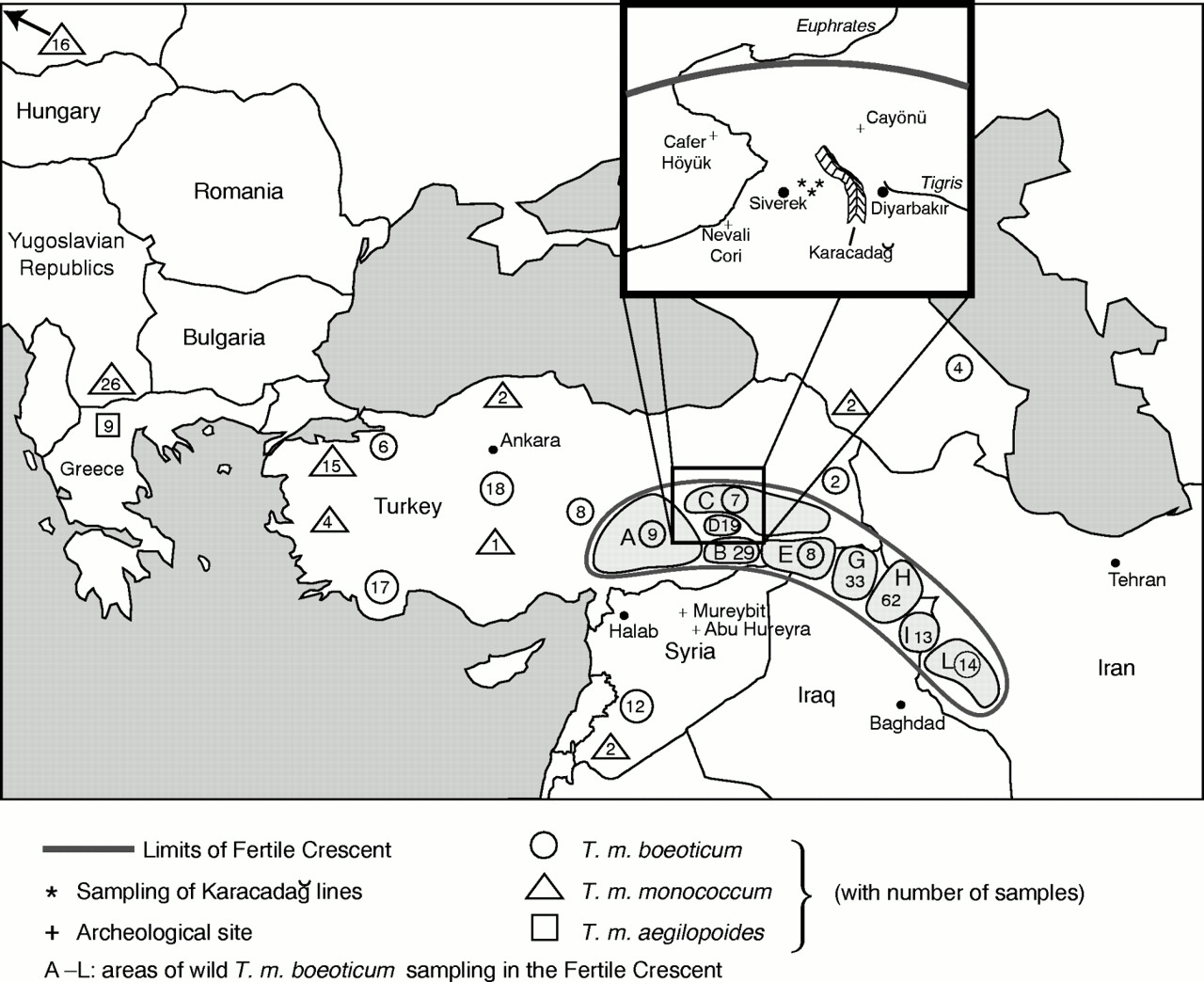
DİYARBEKIR, URFA, MERDÎN = Golden Fertile Crescent
MAP: Scıence 1997.11.14
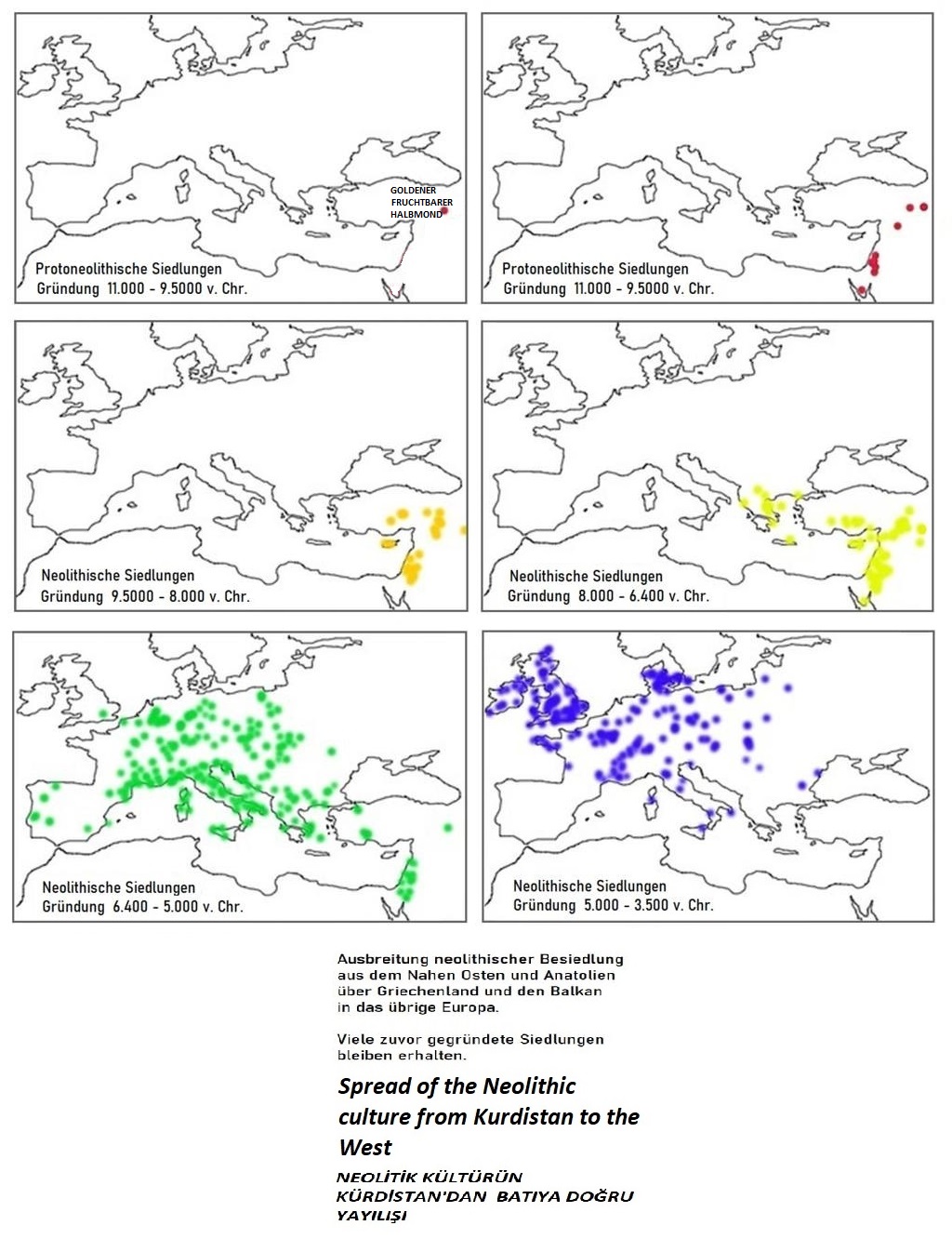
KURDISTAN
- "The Fertile/Golden Crescent"...
a country where civilisation once was born, but now destroyed beyond recognition,
mainly by
Islamo-Fascist Invader Turks.
________________________________
Our Footnotes And Explanations:
1: Besides the 5,8 km long, 17 meters high and 4 meters wide and with its 82 towers, The Geat Ring Wall of Amida (Diyarbekir) – the world's second biggest after the Chinese wall – and in fact this wall is The Biggest City Wall of The World in the city of Amida. It is an architectural master pieces. Year of erection is unkonwn, but it restoarted 349 A.D by the Roman Emperor Justinianus.
It is believed that it was built a thousand years after the agricultural revolution that took place in this particular area which even called Fertile/Golden Cresent. Even today Diyarbekir is the Middle East's wheat stocks. The Agrar Revolution took place for about 11 thousand years ago here ( http://www.saradistribution.com/AgriKurdistan.jpeg ) When the people need to protect production surplus against looting the citadel construction works started to take place.
The Roman Emperor Justinian let it be renovated year 349 AD: http://www.saradistribution.com/great_ring_wall.htm
The city wall in Hawlèr ("Arbil") is also another, a timeless historic structure.
2: The year 1997, almost 30 years after this article was published, the reputed scientific magazine Science (ISSN:0036-8075) published a research study (1997.11.14) from a German research team which conducted a DNA analyses on Wheat samples from all continents of the Earth, and with the aid of this modern technology concluded that all cultivated wheat originates from the mountain areas of Chiya-i Qaraj ("Karajdagh") in the province of Amida (Diar-i Bakr – the city with gıant watermelons) in northern Kurdistan.
3: Savar is since old times the main food source at the Kurdish country side. Wheat grain is boiled and then sun dried. Then the wheat is pounded in a mortar (curn) to get rid of the skin. When ready, the wheat is crushed in a mill (destar) until the wheat is split in 4-6 pieces. In this way a grain food is produced which can be boiled and served.
4: Tell - Kurdish Gir, (hill) – one of the areas most known which in Kurdish is called Girê Elo (Tell Elo), in the city of Amida (Diar-i Bekr), in year 1928 it was opened (as well many other) by the Turkish regime and it’s prehistoric content was taken to Ankara. All this valuable content was probably destroyed. The reason being that it was a matter of the historic heritage of the Kurds, which Turkish rasistic rule is particularly hostile against. No press conferences was held, and of course no scientific studies was made.
5: What in particular has to be emphasized in this context is the important historical role and importance of the woman in the development of mankind. According to the American archaeologist Robert J Braidwood, author of the scientific thesis Preshistoric Investigations in Iraqi Kurdistan, 1960 and the Australian writer and scientist Gordon Child, who wrote the debated book What Happened in History, 1942, was it women themselves who came up with the idea to grow the wild wheat Tiriticum Dicoccoides (Kurdish: Cehdasûk) and bring human kind a step closer to civilisation. But today we witness with great disappointment and disillusionment that in foremost such countries as Turkey, Iran, Iraq, Syria and Saudi Arabia (By and large the whole Middle East) women are treated as an object to own, buy and sell. Why are women - creators of civilisation, treated in this unacceptable fashion? In addition, in the close proximity to the cradle of civilisation. That is one of our times biggest socio – political questions.
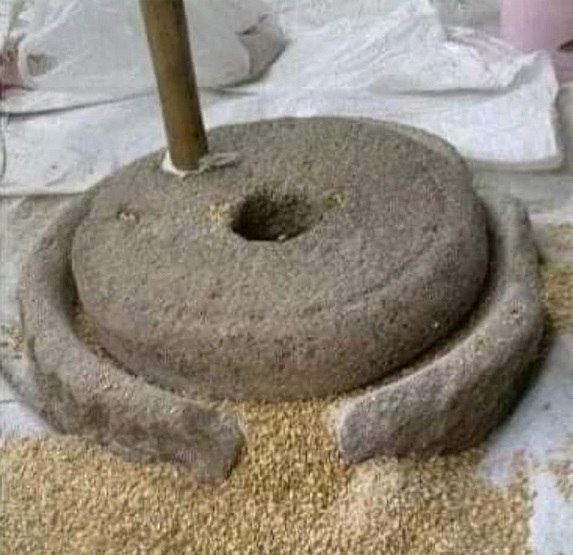
Destar dan dihêre dike bulxur
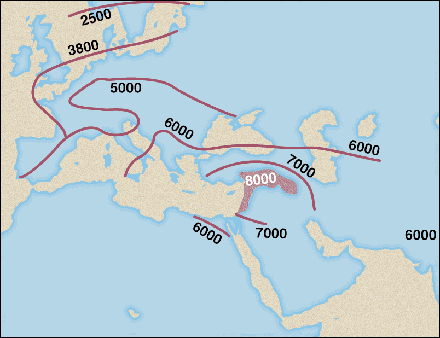
©-SCIENCE. The spread of the art of preparing and cooking meals The art of preparing and cooking meals began 8,000 BC. According to the dates on this map, in general, the knowledge of planting seedlings and the art of domesticating animals began in the geography of historical Kurdistan and from there spread across the face of the earth.
The history of the advanced art and culture of preparing food is 8,000 years old (Science Magazine) and this art was first developed in the lands of the Fertile Crescent, in other words, the land of historical Kurdistan. Historical Kurdistan is the LAND OF FIRSTS FARMERS.
uu

uuuuui ui ©-SCIENCE. Konsten att laga mat började före 8000 fKr. Enligt datumen på denna karta, i allmänhet, började kunskapen om att plantera plantor och konsten att domesticera djur i Kurdistans geografi, och härifrån spreds den över jorden.
Historien om den avancerade konsten och kulturen inom livsmedelsförädling är 8000 år gammal (Science Magazine) och denna konst utspelade sig först i Den bördiga halvmånen, med andra ord, det historiska Kurdistans. Därför är det historiska Kurdistan det FÖRSTA BÖNDERSNAS LANDET.
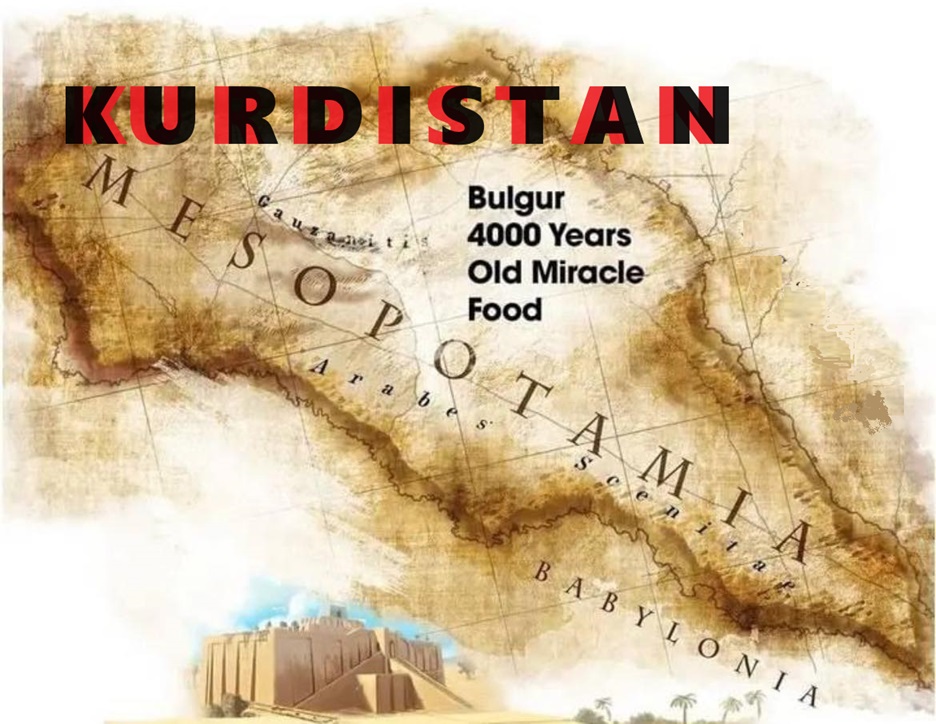
Regular bulgur is made from wheat – wheat that is cooked, crushed and becomes a nutty, flavorful product that also contains a relatively high level of protein. The word "bulgur" originates in the Kurdish language and means "the large piece of grain" (Bılê Gir = Bilgir/Bulgur). Bulgur is of course a Kurdish invention, as wheat was first cultivated in historical Kurdistan.
The early cultivation of wheat and the production of bulgur in Kurdistan demonstrate the area's importance as humanity's first agricultural civilization. Over the centuries, bulgur has spread across much of the world and become an important part of many cuisines, but its original roots in Kurdistan are a reminder of the region's cultural and agrarian heritage.
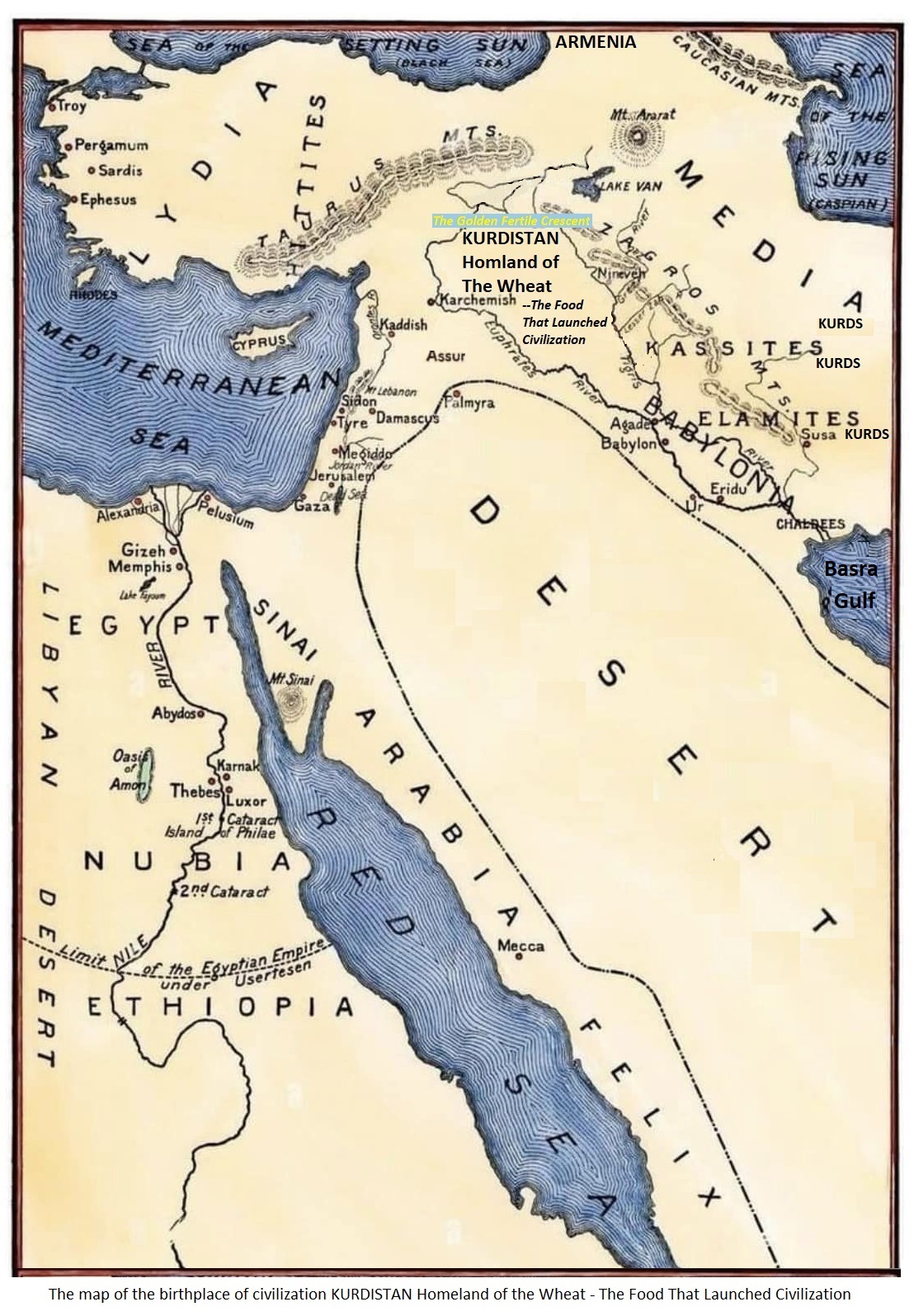
SEMINARIUM
ABOUT KURDISTAN GROUND OF CIVILIZATION
EL PARAÍSO TERENAL EN EL KURDISTÁN
PREHISTORIC SITE OF XIRABRESHK (Girê Navokê) 'Göbekli Tepe'